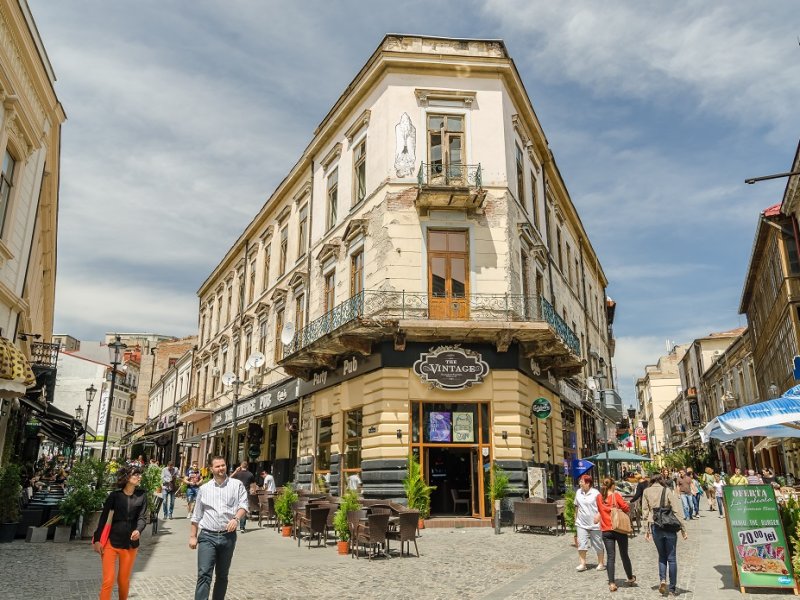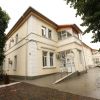Old Center - The history and charm of Bucharest's most famous streets, then and now

By Bucharest Team
- Articles
The Old Center of Bucharest is a place full of history, culture and energy that attracts locals and tourists from all over the world. Also known as "Lipscani", this historic neighborhood is a truly charming place, full of narrow streets and old buildings that take you back to the bohemian atmosphere of Bucharest's bygone days.
Once you step into the Old Center, you'll be amazed to discover a place of contrasts: you'll find both museums and churches - true architectural gems dating back centuries - and nightclubs and bars where young people strip off their inhibitions. On one side of the alleyways you'll discover inns that are hundreds of years old, and on the other, shaormeris ready to delight your taste buds in no time.
In a later article we'll talk more about the Old Town, but today we'll focus on its charming alleyways and the stories that have been written on them since centuries ago:
Old Town - famous streets, then and now
Lipscani - One of the most famous streets in the Old Center has existed since the 17th century, when it was known as Ulița Lipscanilor. In the past, it was the main thoroughfare of Bucharest - the street's name comes from the Lipscani, merchants who brought goods from the German city of Leipzig - or Lipsca, as they called it. In the early days, goods were brought in by Transylvanian Saxons, but in the 18th century, the people of Wallachia gave up this intermediation and started to take them directly from Leipzig. You could find Venetian mirrors, Danzig knives, Flanders cutlery, clothes, clocks and cutlery. But they were not easy to come by - sometimes Romanian merchants' expeditions to Leipzig and back took months.
In 1930, Lipscani became the first pedestrianized street in the area and it must be said that Lipscani is the only street in the Old Town where there are no apartments, only shops or the headquarters of institutions.
Covaci Street - Ulița Covacilor, as it was known at the beginning of the 18th century, got its name, like most of the streets in the Old Center, inspired by a certain trade. In this case, the name comes from the Slavic "kovaci" meaning "blacksmith".
Șepcari Street - The name of the street comes from the trade of the master sawyers who had their workshops here. But even more interesting than that is that this street gave birth to the term "prison" in the sense we know it today. More precisely, on this street there was the "Pușcăria", a tower for the storage of cannons and rifles owned by the Princely Court. This arsenal was used not only in conflicts, but also on the occasion of various holidays that were celebrated with cannon or rifle salutes. With unused space left in the building, it was decided that the cellar would be used to imprison robbers and the belfry to lock up the boyars. Moreover, in 1829, the English consul in Bucharest asked, in a note written in French, for the release of two Englishmen who were "retenus dans les prisons de Pouchkarie".
Academy Street - In the past, school was also held in the Old Town! Opposite the University, on the site of the statues, there used to be the Monastery of St. Sava, built at the end of the 16th century and completely restored by Constantin Brâncoveanu. The rooms of this monastery housed the first high school in Bucharest, known as the School of St. Sava, founded in 1679 by Șerban Cantacuzino. The need of the boyar's children for a good education had to be satisfied, so the so-called "Greek book" could be learned here.
The first Romanian-language high school, founded in 1818 by Gheorghe Lazăr, also opened in this building. Those with the ability could study philosophy and mathematics. The statue of Gheorghe Lazăr still stands there today as a tribute to the extremely important role he played in the progress of Romanian education.
French Street - The French Street is one of the oldest streets in Bucharest, with documents dating it back to the 16th century under the name of "Ulița Mare". The name it still bears today has a simple origin - it was once the residence of the French consul in Bucharest. The street has undergone several changes of route and configuration, but the way we know it today has remained unchanged since 1886.
Macca Villacrosse Passage or the Valley of the Kings - One of the most fascinating places in Bucharest is the Macca Villacrosse Passage or the Valley of the Kings, as most people call it. This is the kingdom of hookahs, with an exceptional history. The passage's name obviously comes from two foreigners: Xavier Villacrosse (sometimes also written as Csavie Vilacros) and Mihalache Macca, the former's brother-in-law. If the former was an architect (of unknown origin) of Bucharest between 1837-1855, the latter was a Greek merchant known for his fur trade. How did the two become brothers-in-law and, lo and behold, how did their names end up on a passage in Bucharest? Well, thanks to their properties and marriages to two sisters of the dragoman - a prestigious profession in the Ottoman Empire that mainly involved diplomatic duties.
Known after the 1990s in urban folklore as the "Valley of the Kings", after the name of the first hookah café in Bucharest, Pasajul Macca-Villacrosse is a unique building in Bucharest. The street on Lipscani Street was named after Villacrosse, while the other, naturally, is named after Macca. You could say that, to a certain extent, it has kept its eastern characteristics combined with the western through cafes and hookah smoke.
Also recommended 5 self-guided walking tours to discover Bucharest on foot






























